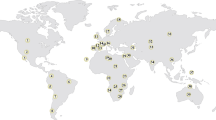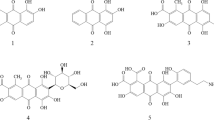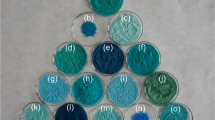Abstract
Always very enlightening, the knowledge of the composition and production of ancient cosmetics has attracted the interest of diverse characterisation studies on archaeological residues in the last decades. Multi-analytical methods are the best option to attain a complete research, prioritising non-destructive techniques, and considering the complexity and the preservation of these ancient materials. X-ray diffraction, infrared and Raman spectroscopies, and electron microscopy with X-ray emission analysis are some of the most consolidated techniques to identify the composition and to reveal the technology of ancient makeups. The present review is mainly focused on the characterisation of inorganic pigments in these cosmetics, even if other ingredients of organic nature could be also included. Some more usual red, black and white components, like ochre, cinnabar, galena, cerussite and madder lake, are highlighted. A brief good practice guide for the analytical study of pigments in archaeological cosmetic residues is described at the end.




Similar content being viewed by others
Data availability
Data sharing is not applicable to this review article as no new data were created or analysed in this study.
Code availability
Not applicable.
References
Aceto M (2021) The palette of organic colourants in wall paintings. Archaeol Anthropol Sci. https://doi.org/10.1007/s12520-021-01392-3
Arizzi A, Cultrone G (2021) Mortars and plasters – how to characterise hydraulic mortars. Archaeol Anthropol Sci. https://doi.org/10.1007/s12520-021-01404-2
Baraldi C, Toti MP, Van Elslande E, Walter P, Gamberini MC (2020) Phoenicians preferred red pigments: chemical compositions of make-up powders found in archaeological sites from Sicily. Appl Spectrosc 74:295–304
Bardinet T (1995) Les papyrus médicaux de l’Egypte pharaonique. Fayard, Paris
Beck L, Caffy I, Delqué-Količ E, Moreau C, Dumoulin J-P, Perron M, Guichard H, Jeammet V (2018) Absolute dating of lead carbonates in ancient cosmetics by radiocarbon. Commun Chem 1:34. https://doi.org/10.1038/s42004-018-0034-y
Becker H (2021) Pigment nomenclature in the ancient Near East, Greece, and Rome. Archaeol Anthropol Sci. https://doi.org/10.1007/s12520-021-01394-1
Bejarano Osorio AM, Bustamante-Álvarez M, Navarro Gascón JV, Marras S, Rodríguez AA (2019) Estudio arqueológico y arqueométrico de restos de cosmético hallados en una pyxis malacológica en Augusta Emerita (Mérida, Badajoz). Sagvntvm 51:177–195. https://doi.org/10.7203/sagvntvm.51.13121
Ben Younès-Krandel A (1992) Boite à fard. In: Fantar MH (ed) Tunisie. Terre de rencontres et de civilisation. Agence Nationale du Patrimoine, Tunis
Bimson M (1980) Cosmetic Pigments from the “Royal Cemetery” at Ur. Iraq 42:75–77
Burgio L (2021) Pigments, dyes and inks – their analysis on manuscripts, scrolls and papyri. Archaeol Anthropol Sci. https://doi.org/10.1007/s12520-021-01403-3
Carington Smith J (1982) A Roman chamber tomb on the southeast slopes of Monasteriki Kephala, Knossos. British School of Athens 77:272–293
Caroselli M, Ruffolo SA, Piqué F (2021) Mortars and plasters – how to manage mortars and plasters conservation. Archaeol Anthropol Sci. https://doi.org/10.1007/s12520-021-01409-x
Castaing J, Walter P, Veyssière P (2007) Extended defects in crystals: examples in powder processing for ancient cosmetics. Appl Phys A 89:865–869. https://doi.org/10.1007/s00339-007-4214-3
Cavallo G, Riccardi MP (forthcoming) Glass-based pigments in painting. Archaeol Anthropol Sci (this Topical Collection)
Cersoy S, Martinetto P, Bordet P, Hodeau JL, Van Elslande E, Walter P (2016) Identifying and quantifying amorphous and crystalline content in complex powdered samples: application to archaeological carbon blacks. J Appl Cryst 49:85–593
Chapman AC, Plenderleith HJ (1926) CCCXLII. - Examination of an ancient Egyptian (Tutankh-Amen) cosmetic. J Chem Soc 129:2614–2619. https://doi.org/10.1039/JR9262902614
Chenciner R (2000) Madder red. A history of luxury and trade-plant dyes and pigments in world commerce and art. Curzon, Richmond
Claro A, Melo MJ, Schäfer S, Seixas de Melo JS, Pina F, van den Berg KJ, Burnstock A (2008) The use of microspectrofluorimetry for the characterization of lake pigments. Talanta 74:922–929
Cotte M, Dumas P, Richard G, Breniaux R, Walter P (2005) New insight on ancient cosmetic preparation by synchrotron-based infrared microscopy. Anal Chim Acta 553:105–110. https://doi.org/10.1016/j.aca.2005.07.067
Daniels V, Devièse T, Hacke M, Higgitt C (2014) Technological insights into madder pigment production in Antiquity. Br Mus Tech Res Bull 8:13–28
Deeb C, Walter P, Castaing J, Penhoud P, Veyssière P (2004) Transmission electron microscopy (TEM) investigations of ancient Egyptian cosmetic powders. Appl Phys A 79:393–396. https://doi.org/10.1007/s00339-004-2543-z
DeLaine J (2021) Production, transport and on-site organisation of Roman mortars and plasters. Archaeol Anthropol Sci. https://doi.org/10.1007/s12520-021-01401-5
Doménech-Carbó MT, Vázquez de Agredos-Pascual ML, Osete-Cortina L, Doménech-Carbó A, Guasch-Ferré N, Manzanilla LR, Vidal-Lorenzo C (2012) Characterization of pre-Hispanic cosmetics found in a burial of the ancient city of Teotihuacan (Mexico). J Archaeol Sci 39:1043–1062
Domingo Sanz I, Chieli A (2021) Characterising the pigments and paints of prehistoric artists. Archaeol Anthropol Sci. https://doi.org/10.1007/s12520-021-01397-y
Dooryhée E, Martinetto P, Walter P, Anne M (2004) Synchrotron X-ray analyses in art and archaeology. Radiat Phys Chem 71:863–868
Eastaugh N, Walsh V, Chaplin T, Siddall R (2008) Pigment compendium: a dictionary and optical microscopy of historic pigments, 1st edn. Butterworth-Heinemann, London
Ergenç D, Fort R, Varas-Muriel MJ, Alvarez de Buergo M (2021) Mortars and plasters – how to characterise aerial mortars and plasters. Archaeol Anthropol Sci. https://doi.org/10.1007/s12520-021-01398-x
Evershed RP, Berstan R, Grew F, Copley MS, Charmant AJH, Barham E, Mottram HR, Brown G (2004) Formulation of a Roman cosmetic. Nature 432:35–36. https://doi.org/10.1038/432035a
Forbes RJ (1965) Studies in ancient technology, vol 3. Brill, Leiden, pp 1–50
Gamberini MC, Baraldi C, Palazzoli F, Ribechini E, Baraldi P (2008) MicroRaman and infrared spectroscopic characterization of ancient cosmetics. Vib Spectrosc 47:82–90. https://doi.org/10.1016/j.vibspec.2008.02.005
Ghazi AM (1994) Lead in archaeological samples: an isotopic study by ICP-MS. Appl Geochem 9:627–636. https://doi.org/10.1016/0883-2927(94)90023-X
Gliozzo E (2021) Pigments – mercury-based red (cinnabar-vermilion) and white (calomel) and their degradation products. Archaeol Anthropol Sci. https://doi.org/10.1007/s12520-021-01402-4
Gliozzo E, Burgio L (2021) Pigments – arsenic-based yellows and reds. Archaeol Anthropol Sci. https://doi.org/10.1007/s12520-021-01431-z
Gliozzo E, Ionescu C (2021) Pigments – lead-based whites, reds, yellows and oranges and their alteration phases. Archaeol Anthropol Sci. https://doi.org/10.1007/s12520-021-01407-z
Gliozzo E, Pizzo A, La Russa MF (2021) Mortars, plasters and pigments − research questions and sampling criteria. Archaeol Anthropol Sci. https://doi.org/10.1007/s12520-021-1393-2
Green P (1979) Ars gratia cultus: Ovid as beautician. Am J Philol 100:381–392
Grüner F (2002) Analysis of crystalline materials preserved in a Palestine kohl vessel from the 4th century AD. Otto Graf J 13:77–82
Han B, Chong J, Sun Z, Jiang X, Xiao Q, Zech J, Roberts P, Rao H, Yang Y (2021) The rise of the cosmetic industry in ancient China: insights from a 2700‐year‐old face cream. Archaeometry 63. https://doi.org/10.1111/arcm.12659
Hardy AD, Walton RI, Vaishnav R, Myers KA, Power MR, Pirrie D (2006) Egyptian eye cosmetics (kohls): past and present. In: Bradley D, Creagh D (eds) Physical techniques in the study of art, archaeology and cultural heritage, 1. Elsevier, Amsterdam, pp 173–203
Hodgskiss T, Wadley L (2017) How people used ochre at Rose Cottage Cave, South Africa: sixty thousand years of evidence from the middle stone age. PLoS ONE 12:e0176317. https://doi.org/10.1371/journal.pone.0176317
Hottentot W, Van Lith SME (2006) Römische Schönheitspflegemittel in Kugeln un Vögeln aus Glas. Babesch - Bulletin Antieke Beschaving 81:185–198. https://doi.org/10.2143/BAB.81.0.2014428
Huq A, Stephens PW, Ayed N, Binous H, Burgio L, Clark RJH, Pantos E (2006) Combined technique analysis of the composition of Punic make-up materials. Appl Phys A 83:253–256. https://doi.org/10.1007/s00339-006-3518-z
Isings C (1957) Roman glass from dated finds. Academiae Rheno-Traiectinae Instituto Archaeologico, Groningen- Djakarta
Karmous T, Ayed N, Fantar MH, Wouters J (1996) Analysis of Punic natural dyes: purple earth from Zembra and cosmetic make-up from Carthage (Carthago, Tunisia). Dyes Hist Archaeol 14:3–8
Kiehn AV, Brook GA, Glascock MD, Dake JZ, Robbins LH, Campbell AC, Murphy ML (2007) Fingerprinting specular hematite from mines in Botswana, Southern Africa. ACS Symp Ser 968:460–479. https://doi.org/10.1021/bk-2007-0968.ch025
Knapp CW, Christidis GE, Venieri D, Gounaki I, Gibney-Vamvakari J, Stillings M, Photos-Jones E (2021) The ecology and bioactivity of some Greco-Roman medicinal minerals: the case of Melos earth pigments. Archaeol Anthropol Sci. https://doi.org/10.1007/s12520-021-01396-z
La Russa MF, Ruffolo SA (2021) Mortars and plasters − how to characterise mortars and plasters degradation. Archaeol Anthropol Sci. https://doi.org/10.1007/s12520-021-01405-1
Lancaster LC (2021) Mortars and plasters – how mortars were made. The Literary Sources. Archaeol Anthropol Sci. https://doi.org/10.1007/s12520-021-01395-0
Leona M, Stenger J, Ferloni E (2006) Application of surface enhanced Raman scattering techniques to the ultrasensitive identification of natural dyes in works of art. J Raman Spectros 3:981–992
Lettieri M, Giannotta MT (2017) Investigations by FT-IR spectroscopy on residues in pottery cosmetic vases from archaeological sites in the Mediterranean basin. Int J Exp Spectroscopic Tech 2:009
Lucas A (1930) Cosmetics, perfumes and incense in ancient Egypt. J Egypt Archaeol 16:41–53
Lucas A, Harris JR (1962) Ancient Egyptian materials and industries, 4th edn. Edward Arnold, London, pp 80–97
Mai H, Yang Y, Abuduresule I, Li W, Hu X, Wang C (2016) Characterization of cosmetic sticks at Xiaohe cemetery in early Bronze Age Xinjiang, China. Sci Rep 6:18939. https://doi.org/10.1038/srep18939
Manniche L (1989, revised edn. 2006) An ancient Egyptian herbal. The British Museum Press, London, p 47
Manniche L (1999) Sacred luxuries: fragrance, aromatherapy and cosmetics in ancient Egypt. Opus Publishing Ltd., London
Marcaida I, Maguregui M, Morillas H, García-Florentino C, Knuutinen U, Carrero JA, Fdez-Ortiz de Vallejuelo S, Pitarch Martı́ A, Castro K, Madariaga JM (2016) Multispectroscopic and isotopic ratio analysis to characterize the inorganic binder used on Pompeian pink and purple lake pigments. Anal Chem 88:6395–6402. https://doi.org/10.1021/acs.analchem.6b00864
Marcaida I, Maguregui M, Morillas H, García-Florentino C, Pintus V, Aguayo T, Campos-Vallette M, Madariaga JM (2017) Optimization of sample treatment for the identification of anthraquinone dyes by surface-enhanced Raman spectroscopy. Anal Bioanal Chem 409:2221–2228. https://doi.org/10.1007/s00216-016-0169-6
Martinetto P, Anne M, Dooryhée E, Tsoucaris G, Walter P (2000a) X-ray diffraction analysis of cosmetic formulations from Ancient Egypt. J Phys IV 10:465–472
Martinetto P, Anne M, Dooryhée E, Walter P (2000b) X-ray diffraction line broadening analysis of galena powders: a clue to some practices on mineral crushing in ancient Egypt. European Powder Diffraction, Pts 1 and 2 (Materials Science Forum series) 321–3:1062–1067. https://doi.org/10.4028/www.scientific.net/MSF.321-324.1062
Martinetto P, Anne M, Dooryhée E, Drakopoulos M, Dubus M, Salomon J, Simionovici A, Walter P (2001) Synchrotron X-ray micro-beam studies of ancient Egyptian make-up. Nucl Instr Meth Phys Res B 181:744–748
Mastrotheodoros GP, Beltsios KG, Bassiakos Y (forthcoming) Pigments – iron-based red, yellow and brown ochres. Archaeol Anthropol Sci (this Topical Collection)
Mazzocchin GA, Agnoli F, Mazzocchin S (2003) Investigation of a Roman age “bulk pigment” found in Vicenza. Anal Chim Acta 475:181–190
Moorey PRS (1999) Ancient Mesopotamian materials and industries: the archaeological evidence. Eisenbrauns - The Pennsylvania State University Press, Pennsylvania, pp 134–139
Murat Z (2021) Wall paintings through the ages. The medieval period (Italy, 12th-15th century). Archaeol Anthropol Sci. https://doi.org/10.1007/s12520-021-01410-4
Nunn JF (1996) Ancient Egyptian medicine. British Museum Press, London, p 146
Olson K (2009) Cosmetics in Roman Antiquity: substance, remedy, poison. Classical World 102:291–310
Palamara E, Zacharias N, Papakosta L, Palles D, Kamitsos EI, Pérez-Arantegui J (2016) Studying a funerary Roman vessel glass collection from Patras, Greece: an interdisciplinary characterisation and use study. STAR: Sci Technol Archaeol Res 2:203–216. https://doi.org/10.1080/20548923.2016.1239868
Patriarche G, Van Elslande E, Castaing J, Walter P (2014) Aberration corrected STEM to study an ancient hair dyeing formula. AIP Conf Proc 1598:14–17. https://doi.org/10.1063/1.4878268
Pérez-Arantegui J, Cepriá G (2014) Suitability of the voltammetry of immobilized microparticles to detect and discriminate lead compounds in microsamples of ancient black cosmetics. Electrochim Acta 138:247–255. https://doi.org/10.1016/j.electacta.2014.06.085
Pérez-Arantegui J, Cepriá G, Ribechini E, Degano I, Colombini MP, Paz-Peralta J, Ortiz-Palomar E (2009) Colorants and oils in Roman make-ups-an eye witness account. TrAC - Trends Anal Chem 28:1019–1028
Pérez-Arantegui J, Larrea A (2015) Electron backscattering diffraction as a complementary analytical approach to the microstructural characterization of ancient materials by electron microscopy. TrAC - Trends Anal Chem 72:193–201. https://doi.org/10.1016/j.trac.2015.03.026
Pérez-Arantegui J, Paz-Peralta J, Ortiz-Palomar E (1996) Analysis of the products contained in two Roman glass unguentaria from the colony of Celsa (Spain). J Archaeol Sci 23:649–655
Pliny (1998) Historia Naturalis, Books XIII and XV. In: Historia Natural de Cayo Plinio Segundo, Vol. II, Visor Libros, Madrid, Spain
Ribechini E, Modugno F, Pérez-Arantegui J, Colombini MP (2011) Discovering the composition of ancient cosmetics and remedies: analytical techniques and materials. Anal Bioanal Chem 401:1727–1738. https://doi.org/10.1007/s00216-011-5112-2
Roebroeks W, Sier MJ, Kellberg Nielsen T, De Loecker D, Parés JM, Arps CES, Mücher H (2012) Use of red ochre by early Neandertals. Proc Natl Acad Sci USA 109:1889–1894
Şahin F (2020) A ‘kohl box’ from the Cilician plain in the frame of the analytical and archaeological evidence. Mediter Archaeol Archaeom 20:173–187. https://doi.org/10.5281/zenodo.3707804
Salvadori M, Sbrolli C (2021) Wall paintings through the ages. The Roman period: Republic and early Empire. Archaeol Anthropol Sci. https://doi.org/10.1007/s12520-021-01411-3
Schafer EH (1956) The early history of lead pigments and cosmetics in China. T’oung Pao 44:413–438. https://doi.org/10.1163/156853256X00135
Schweppe H, Winter J (1997) Madder and Alizarin. In: Fitz-Hugh EW (ed) Artists’ pigments. A handbook of their history and characteristics, vol 3. Oxford University Press, Oxford, pp 109–142
Scott DA (2016) A review of ancient Egyptian pigments and cosmetics. Stud Conserv 61:185–202
Shortland AJ, Nicholson PT, Jackson CM (2000) Lead isotopic analysis of eighteenth-dynasty Egyptian eyepaints and lead antimonate colourants. Archaeometry 42:153–157
Sotiropoulou S, Perdikatsis V, Apostolaki Ch, Karydas AG, Devetzi A, Birtacha K (2010) Lead pigments and related tools at Akrotiri, Thera, Greece. Provenance and application techniques. J Archaeol Sci 37:1830–1840. https://doi.org/10.1016/j.jas.2010.02.001
Švarcová S, Hradil D, Hradilová J, Čermáková Z (2021) Pigments – copper-based greens and blues. Archaeol Anthropol Sci. https://doi.org/10.1007/s12520-021-01406-0
Tapsoba I, Arbault S, Walter P, Amatore C (2010) Finding out Egyptian Gods’ secret using analytical chemistry: biomedical properties of Egyptian black makeup revealed by amperometry at single cells. Anal Chem 82:457–460
Trombert E (1997) Des fleurs rouges en galette. Une plante tinctoriale de la Chine ancienne: le carthame. J Asiat 285:509–547
Ungár T, Martinetto P, Ribárik G, Dooryhée E, Walter P, Anne M (2002) Revealing the powdering methods of black makeup in Ancient Egypt by fitting microstructure based Fourier coefficients to the whole X-ray diffraction profiles of galena. J Appl Phys 91:2455–2465. https://doi.org/10.1063/1.1429792
Van Elslande E, Guérineau V, Thirioux V, Richard G, Richardin P, Laprévote O, Hussler G, Walter P (2008a) Analysis of ancient Greco-Roman cosmetic materials using laser desorption ionization and electrospray ionization mass spectrometry. Anal Bioanal Chem 390:1873–1879. https://doi.org/10.1007/s00216-008-1924-0
Van Elslande E, Lecomte S, Le Hô A-S (2008b) Micro-Raman spectroscopy (MRS) and surface-enhanced Raman scattering (SERS) on organic colourants in archaeological pigments. J Raman Spectros 39:1001–1006
Vázquez de Ágredos Pascual ML, Gamberini MC, Walter P (2018) Perfumes and cosmetics. In: López Varela SL (ed) The encyclopedia of archaeological sciences. John Wiley & Sons, Inc., Wiley Online Library. https://doi.org/10.1002/9781119188230.saseas0447
Vázquez de Ágredos-Pascual ML, Zapata-Meza M, Sanz-Rincón R, Garza Díaz-Barriga A, Expósito De Vicente C, Rojo-Iranzo L, Herreras Sala S (2019) Physicochemical and cultural study of coloring materials from 1st c. AD Magdala, Lower Galilee. Mediter Archaeol Archaeom 19:173–188. https://doi.org/10.5281/zenodo.3583077
Vidale M, Craig O, Desset F, Guida G, Bianchetti P, Sidoti G, Mariottini M, Battistella E (2012) A chlorite container found on the surface of Shahdad (Kerman, Iran) and its cosmetic content. Iran 50:27–44. https://doi.org/10.1080/05786967.2012.11834711
Vidale M, Salviulo G, Zorzi F, Mocchiutti I (2016) Cosmetics and cosmetology at Shahr-i Sokhta. Iran 54:1–24. https://doi.org/10.1080/05786967.2016.11879211
Vitti P (2021) Mortars and masonry – Structural lime and gypsum mortars in Antiquity and Middle Ages. Archaeol Anthropol Sci. https://doi.org/10.1007/s12520-021-01408-y
Walter P, Martinetto P, Tsoucaris G, Bréniaux R, Lefebvre MA, Richard G, Talabot J, Dooryhee E (1999) Making make-up in Ancient Egypt. Nature 397:483–484
Walter P, Welcomme E, Hallégot P, Zaluzec NJ, Deeb C, Castaing J, Veyssière P, Bréniaux R, Lévêque J-L, Tsoucaris G (2006) Early use of PbS nanotechnology for an ancient hair dyeing formula. Nano Lett 6:2215–2219
Welcomme E, Walter P, Van Elslande E, Tsoucaris G (2006) Investigation of white pigments used as make-up during the Greco-Roman period. Appl Phys A 83:551–556. https://doi.org/10.1007/s00339-006-3559-3
Wellman M (1958) Dioscoridis Pedanii de Materia Medica. Libri Quinque. Weidmannsche, Vienna
Wilner OL (1931) Roman beauty culture. Class J 27:26–38
Wouters J, Grzywacz CM, Claro A (2010) Markers for identification of faded safflower (Carthamus tinctorius L.) colorants by HPLC-PDA-MS - ancient fibres, pigments, paints and cosmetics derived from antique recipes. Stud Conserv 55:186–203. https://doi.org/10.1179/sic.2010.55.3.186
Yamada M-O, Minami T, Yamada G, Tohno Y, Tohno S, Ikeda Y, Tashiro T, Kohno Y, Kawakami K (1997) Different element ratios of red cosmetics excavated from ancient burials of Japan. Sci Total Environ 199:293–298
Yu ZR, Wang XD, Su BM, Zhang Y (2017) First evidence of the use of freshwater pearls as a cosmetic in ancient China: analysis of white makeup powder from a northern Song dynasty Lv tomb (Lantian, Shaanxi Province, China). Archaeometry 59:762–774
Zilhão J (2012) Personal ornaments and symbolism among the Neanderthals. Dev Quat Sci 16:35–49
Zilhão J et al (2010) Symbolic use of marine shells and mineral pigments by Iberian Neanderthals. Proc Natl Acad Sci USA 107:1023–1028. https://doi.org/10.1073/pnas.0914088107
Author information
Authors and Affiliations
Corresponding author
Ethics declarations
Conflict of interest
The author declares no competing interests.
Additional information
Publisher’s note
Springer Nature remains neutral with regard to jurisdictional claims in published maps and institutional affiliations.
This article is part of the Topical Collection on Mortars, plasters and pigments: Research questions and answers
Rights and permissions
About this article
Cite this article
Pérez-Arantegui, J. Not only wall paintings—pigments for cosmetics. Archaeol Anthropol Sci 13, 189 (2021). https://doi.org/10.1007/s12520-021-01399-w
Received:
Accepted:
Published:
DOI: https://doi.org/10.1007/s12520-021-01399-w




